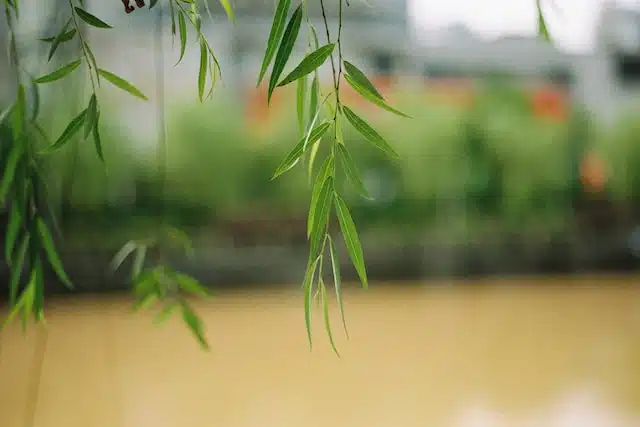Willow trees are a fascinating species of trees that belong to the genus Salix. They are often associated with water and wetlands, and their characteristic long, slender leaves and flexible branches make them easy to identify. Willows are found all over the world, in a range of different habitats and environments, from the Arctic tundra to the tropical rainforest. In this article, we will explore the characteristics, distribution, and cultural significance of willow trees, as well as their ecological importance and practical uses.
Characteristics:
Willow trees are typically medium-sized deciduous trees, although some species can grow up to 40 meters tall. They have long, narrow leaves that are usually green or grey-green in color and are often covered in fine hairs. The leaves are typically between 5 and 15 centimeters long and have a pointed tip. The bark of willow trees is often smooth and grey, although some species have rougher or more textured bark.
One of the defining features of willow trees is their flexible branches, which can be bent and shaped without breaking. This makes them useful for a range of practical applications, including basket weaving, furniture making, and the production of cricket bats. Willow branches are also often used as a natural support for climbing plants, such as vines and roses.
Another characteristic of willow trees is their catkins, which are long, slender clusters of flowers that appear in the spring. The male catkins are typically yellow or green and produce large amounts of pollen, while the female catkins are green or red and produce seeds that are surrounded by a fluffy white substance known as “pussy willow.
Distribution:
Willow trees are found all over the world, from the Arctic tundra to the tropical rainforest. They are particularly abundant in wetland areas, such as marshes, swamps, and riverbanks, where their deep root systems help to stabilize the soil and prevent erosion. Willows are also often found in areas that have been disturbed by human activity, such as along roadsides, railway lines, and canals.
There are around 400 different species of willow trees, which are distributed across the Northern Hemisphere. The largest concentration of willow species is found in China, where around 300 different species are found. Other areas with a high concentration of willow species include North America, Europe, and Asia.
Cultural Significance:
Willow trees have played an important role in human culture for thousands of years. In many cultures, willow trees are associated with water, which is seen as a symbol of life, purification, and regeneration. In ancient Egypt, willow branches were used in religious ceremonies and were believed to have healing powers. In China, willow branches are often used in traditional medicine to treat a range of conditions, including headaches, fever, and arthritis.
Willow trees have also been the subject of many works of art, including paintings, poems, and songs. The American folk song “Oh, Shenandoah” includes the lyrics “Oh, Shenandoah, I long to hear you, Away, you rolling river, Oh, Shenandoah, I long to hear you, Away, I’m bound away, Across the wide Missouri”. The song is believed to be based on an old Native American song that references the willow trees that grow along the Missouri River.
Ecological Importance:
Willow trees play an important role in a range of different ecosystems and provide numerous benefits to the environment. One of the most important ecological functions of willow trees is their ability to stabilize soil and prevent erosion. The deep root systems of willow trees help to hold the soil in place, which can be particularly important in areas that are prone to flooding or landslides.
Willow trees are also important for wildlife, providing habitat and food for a range of different animals, including birds, insects, and mammals. The leaves of willow trees are a food source for many species of caterpillar, which in turn are eaten by birds. The catkins of willow trees are an important source of food for bees and other pollinators, while the bark and branches are used by a range of different mammals, including beavers, muskrats, and rabbits.
In addition to their ecological importance, willow trees have a range of practical uses. The flexible branches of willow trees are used in basket weaving, furniture making, and the production of cricket bats. Willow branches are also often used as a natural support for climbing plants, such as vines and roses.
Practical Uses:
Willow trees have been used for a range of practical purposes for thousands of years. One of the most important uses of willow trees is in basket weaving. Willow branches are flexible and easy to bend, making them ideal for creating baskets of all shapes and sizes. Willow baskets have been used for storing food, carrying water, and as a decorative item for thousands of years.
Willow trees are also commonly used in furniture making. The flexible branches of willow trees are ideal for creating chairs, tables, and other items of furniture. Willow furniture is lightweight and durable, making it ideal for use both indoors and outdoors.
Another practical use of willow trees is in the production of cricket bats. Willow wood is lightweight and has a natural shock-absorbing quality, making it ideal for use in cricket bats. The best cricket bats are made from a specific type of willow known as English willow, which is grown in the UK.
Conclusion:
Willow trees are a fascinating species of tree that are found all over the world. Their long, slender leaves and flexible branches make them easy to identify, while their catkins and deep root systems are important for the environment. Willow trees have played an important role in human culture for thousands of years, and have been used for a range of practical purposes, including basket weaving, furniture making, and the production of cricket bats. Whether admired for their beauty, valued for their ecological importance, or utilized for their practical uses, willow trees are a species that deserves to be celebrated and protected.





























